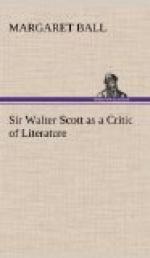The peculiar conditions under which Swift’s writings had appeared, and his remarkable indifference to literary fame, gave the editor opportunity to look for material which had not before been included in his works. The diligent search of Scott and his various correspondents enabled him to add about thirty poems, between sixty and seventy letters from Swift, and about sixteen other small pieces. The most noteworthy item among these additions was the correspondence between Swift and Miss Vanhomrigh, of which only a very small part had previously been made public.[188]
Scott’s notes seem to indicate that most of the necessary searching through newspapers and obscure pamphlets for forgotten work of Swift was performed by “obliging correspondents,” and that the editor himself had only to pass judgment on what was brought to his attention. This impression may arise largely from his cordiality in expressing indebtedness to his helpers, but it is certain that his position as a popular poet gave Scott the assistance of many people who would not have been enlisted in the work by an ordinary editor. But Scott had the difficult task of deciding whether the unauthenticated pieces were to be assigned to Swift. The bibliography of Swift is still so uncertain that it is impossible to say how many of the small pamphlets in verse and prose added in this edition are really his work.[189] Scott had good reason for his additions in most cases, though sometimes, as he was aware, the Dean had merely revised the work of other people. The editor was occasionally over-credulous in attributing pieces to Swift, but he was perhaps oftener too generous in giving room to things which he knew had very little claim to be considered Swift’s work. When he was in doubt he chose to err on the safe side, according to the principles set forth in the following note on the Letter from Dr. Tripe to Nestor Ironside: “The piece contains a satirical description of Steele’s person, and should the editor be mistaken in conjecturing that Swift contributed to compose it, may nevertheless, at this distance of time, merit preservation as a literary curiosity."[190] The ample space afforded by the nineteen volumes of the book gives room to Arbuthnot’s History of John Bull—because it was “usually published in Swift’s works,”—to the verses addressed to the Dean and those written in memory of him, as well as to the prose and verse miscellanies of Pope and Swift, and the miscellanies and jeux d’esprit of Swift and Sheridan. Swift’s correspondence fills the last four and a half volumes.
The biography, which occupies the first volume, is admirable in tone, but the facts Scott gives are less to be relied upon than the inferences and conclusions he derives from them. He corresponded with persons who were in a position to know about Swift from his friends and acquaintances, and probably he trusted too much to these “original sources.” We find, as perhaps the most noteworthy instance, that




